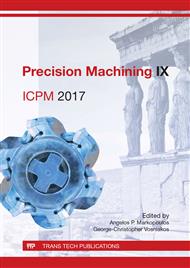[1]
M. Hadad, M. Ramezani: Modelling and analysis of a novel approach in machining and structuring of flat surfaces using face milling process, Int. Journal of Machine Tools and Manufacture, 105 (2016) 32-44.
DOI: 10.1016/j.ijmachtools.2016.03.005
Google Scholar
[2]
A.P. Markopoulos, S. Georgiopoulos, D.E. Manolakos: On the use of back propagation and radial basis function neural networks in surface roughness prediction, Journal of Industrial Engineering International, 12 (2016) 389-400.
DOI: 10.1007/s40092-016-0146-x
Google Scholar
[3]
N.E. Karkalos, N.I. Galanis, A.P. Markopoulos: Surface roughness prediction for the milling of Ti-6Al-4V ELI alloy with the use of statistical and soft computing techniques, Measurement 90 (2016) 25-35.
DOI: 10.1016/j.measurement.2016.04.039
Google Scholar
[4]
B. Karpuschewski, T. Emmer, K. Schmidt, D.T. Nguyen.: Rundschaft Werkzeugsystem – universell und flexibel einsetzbar in Forschung und Produktion, Proceedings of 12th International Conference of Tools ICT-2007, Miskolc (2007) 53-62.
Google Scholar
[5]
B. Karpuschewski, S. Batt: Improvement of Dynamic Properties in Milling by Integrated Stepped Cutting, CIRP Annals, 56(1) (2007) 85-88.
DOI: 10.1016/j.cirp.2007.05.001
Google Scholar
[6]
T.L. Schmitz, J. Couey, E. Marsh, N. Mauntler, D. Hughes: Runout effects in milling: surface finish, surface location error and stability, Int. J. Mach. Tools Manuf., 47 (2006), 841–851.
DOI: 10.1016/j.ijmachtools.2006.06.014
Google Scholar
[7]
H. Hassanpour, M.H. Sadeghi, A. Rasti, S. Shajari: Investigation of surface roughness, microhardness and white layer thickness in hard milling of AISI 4340 using minimum quantity lubrication, Journal of Cleaner Production, 120 (2016) 124–134.
DOI: 10.1016/j.jclepro.2015.12.091
Google Scholar
[8]
N. Masmiati, A.A.D. Sarhan, M.A.N. Hassan, M. Hamdi: Optimization of Cutting Conditions for Minimum Residual Stress, Cutting Force and Surface Roughness in End Milling of S50c Medium Carbon Steel, Measurement, 86 (2016) 253–265.
DOI: 10.1016/j.measurement.2016.02.049
Google Scholar
[9]
Y. Takeuchi, M. Sakamoto: Analysis of machining error in face milling, Journal of the Japan Society of Precision Engineering, 47(7) (1981) 874-879.
Google Scholar
[10]
F. Gu, S.N. Melkote, S.G. Kapoor, R.E. DeVor: A Model for the Prediction of Surface Flatness in Face Milling, J. Manuf. Sci. Eng. 119(4A) (1997) 476-484.
DOI: 10.1115/1.2831177
Google Scholar
[11]
A.E. Diniz, J.C. Filho: Influence of relative position of tool and workpiece on the tool life, tool wear and surface finish in the face milling process, Wear, 232(1) (1999) 67–75.
DOI: 10.1016/s0043-1648(99)00159-3
Google Scholar
[12]
V. Gyliené, V. Eidukynas: The Numerical Analysis of Cutting Forces in High Feed Face milling, Assuming the Milling Tool Geometry, Procedia CIRP, 46 (2016) 436-439.
DOI: 10.1016/j.procir.2016.03.132
Google Scholar
[13]
L.C. da Silva, P.R. da Mota, M.B. de Silva, E. Okechugwu, Á.R. Machado: Study of burr height face milling of PH 13-8 Mo stainless steel – Transition from primary to secondary burr and benefits of deburring between passes, CIRP Journal of Manufacturing Science and Technology, 10 (2015).
DOI: 10.1016/j.cirpj.2015.05.002
Google Scholar
[14]
H.M.B. de Carvalho, J. de Oliveira Gomes, M.A. Schmidt, V.L.C. Brandäo: Vibration Analysis and Energy Efficiency in Interrupted Face Milling Processes, Procedia CIRP, 29 (2015) 245-250.
DOI: 10.1016/j.procir.2015.02.165
Google Scholar
[15]
B. Denkena, E. Hasselberg: Influence of Cutting Tool Compliance on Workpiece Surface Shape in Face Milling of Workpiece Compounds, Procedia CIRP, 31 (2015) 7-12.
DOI: 10.1016/j.procir.2015.03.074
Google Scholar


